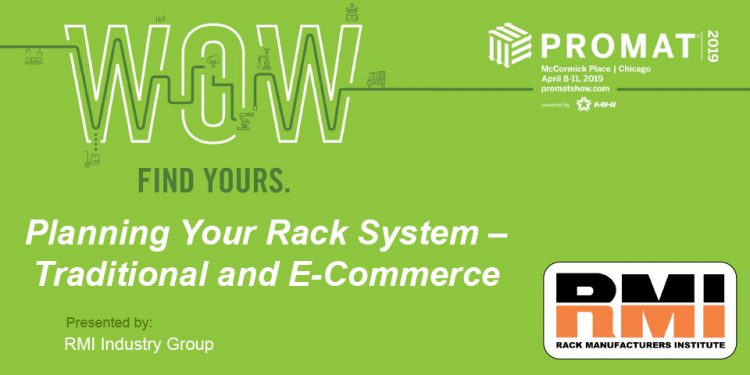Learn How To Design The Optimal Rack System For Traditional And E-Commerce Operations

With traditional retail distribution relying on full pallet movement and/or picked cases, while e-commerce distribution is typically comprised of reserve, full pallet storage used to replenish a pick module or other each picking system, it stands to reason that each type of fulfillment would require a different type (or types) of racking. And that reasoning would be correct. In an RMI on-floor educational session held during ProMat 2019, members shared insights about the differences between the two types of distribution, and how to design and select the optimal industrial steel storage rack system for each.
Entitled “Planning Your Rack System—Traditional and E-Commerce,” a synchronized recording of the slides and audio is available for those who were unable to attend the session, or who wish to revisit the information.
The first part of the seminar guides participants through the changes in retail distribution and how warehouse and rack designs are evolving to meet the needs of these two distinct types of fulfillment. Notably, data analysis of nearly 60 major U.S. markets shows that the majority of facilities built before 2005 have a variety of limitations that hinder the each picking requirements common to e-commerce applications. Among them are low ceilings, small footprints, uneven floors and inadequate dock space. Additionally, in the past 30 years, stock keeping units (SKUs) handled in retail storefronts have increased exponentially.
As traditional retailers learned they couldn’t process an e-commerce order out of the same facility used to replenish brick-and-mortar stores, they began to establish separate operations. In the second section of the presentation, a key rule of thumb is offered as a basis for the initial determination of the best type of racking system for a given operation: how many pallets per SKU will be handled within the facility.
- The larger the number of pallets per SKU, the better suited the application is for high-density storage systems such as drive-in rack, flow rack or pallet shuttle systems.
- The fewer the number of pallets per SKU, the better suited the application is for use of selective pallet racking and/or case-flow racks.
An overview of the range of available racking and storage systems is also covered in the session, including an explanation of the differences between roll-formed racks and structural steel racks. Full pallet storage rack system choices include selective, double-deep reach, pushback, drive-in, drive-thru, double pallet drive-in, pallet flow, pallet shuttles, and high-rise automated storage and retrieval systems (AS/RS). For case and each picking processes, choices include carton flow racks placed into standard racking or are fitted to separate support frames, mezzanines, and In a 20-minute ProMat educational session, RMI members offer insights into the many storage rack options available to handle retail fulfillment. are explained.
Have more industrial storage rack system design questions? Visit RMI’s page of frequently asked questions (FAQs).


